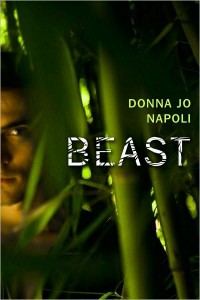
 It’s hard not to be familiar with the Beauty and the Beast fairy tale, even if the version most people are familiar with is the Disney movie. Man finds abandoned castle, steals a rose to bring back for the sake of his youngest daughter, and is captured by the castle’s owner, a monstrous beast with the power to communicate with humans. In return for his own life, the man — often a merchant of some sort — must send his daughter to serve the beast. The deal is honored, the girl goes to the castle, and meets the beast, subsequently forging a fragile friendship/relationship with him. Ultimately, she returns home for a visit, and stays until she realizes she loves the beast, returning to his side just as he’s about to expire of loneliness. Her love frees him from an evil spell, restoring his human form, and they live happily ever after.
It’s hard not to be familiar with the Beauty and the Beast fairy tale, even if the version most people are familiar with is the Disney movie. Man finds abandoned castle, steals a rose to bring back for the sake of his youngest daughter, and is captured by the castle’s owner, a monstrous beast with the power to communicate with humans. In return for his own life, the man — often a merchant of some sort — must send his daughter to serve the beast. The deal is honored, the girl goes to the castle, and meets the beast, subsequently forging a fragile friendship/relationship with him. Ultimately, she returns home for a visit, and stays until she realizes she loves the beast, returning to his side just as he’s about to expire of loneliness. Her love frees him from an evil spell, restoring his human form, and they live happily ever after.
Take this as you will — for a fairy tale; for an extended metaphor on the power of love; for a commentary on the dual nature of man and beast within us all; for a morality play, what-have-you. The tale has been told and retold innumerable times, though the one we’re most used to has its roots in the French parlor tales of the 18th Century, later incorporated into larger collections. Compared to the earliest versions, Disney was a Johnny-Come-Lately.
Donna Jo Napoli, whose previous books have dealt with similar matters( Zel, for instance, retelling Rapunzel), draws from the 1811 poem by Charles Lamb to restructure and recount the Beauty and the Beast from a more intimate point of view. Namely, from the vantage point of the Beast himself. Inspired by Lamb’s version, Napoli gives the Beast the true name of Orasmyn, a Prince of Persia cursed by a vengeful fairy into the shape of a lion, after he makes an unwise, or perhaps uninformed, decision during the Islamic Feast of Sacrifices.
As a lion, Orasmyn is forced to flee his home for fear of his very life, leaving behind everything he knows, including his family and his beloved rose gardens. Armed only with his own learning and human intelligence, neither man nor beast in truth, he must make a new life for himself. His only comfort lies in the fairy’s declaration that only the love of a woman will set him free. And thus begins an odyssey for the former Prince. Daily, his beast nature wars with his human side, and he struggles to maintain the laws of his Persian Islamic faith, hoping that the structure may preserve his sense of identity. He finds no home for himself in India, thinking to become lion in truth but unable to compete with those lions born to the form. Ultimately, his journey takes him to France, a place marked in his mind as a land of beauty and love. There, he finds an abandoned castle, thought by the locals to be haunted, and sets up residence as best he can, encumbered by his lion form. The rest of the story we know. How a merchant finds refuge for the night. How a deal is made. How a lovely young woman comes to the castle. And how they grow ever closer, until she leaves and almost doesn’t come back in time…
The strengths of Napoli’s retelling come in the lush language, the rich detail, and the attention to Orasmyn’s struggle between faith and instinct. She captures not just the exotic beauty of the Persian court, but also the more earthy appeal of Belle and the contrast between cultures. We can never forget that Orasmyn, the Beast, is inhuman — a lion in body, a man in spirit — and that even blessed (cursed?) with his human intelligence, he can no more interact normally with humans than a real lion could.
There’s very little magic in this story, beyond the initial spell which transforms and curses Orasmyn. There are no invisible servants, no singing and dancing furniture, no pyrotechnics. But all it takes is a single spell to set up a story’s worth of magic and the repercussions. The real magic lies in the telling, and in Napoli’s ability to really get inside the head of the Beast, and make us understand what sort of conflict he was going through daily. Her status as a professor of linguistics at Swarthmore is clearly a major inspiration and resource in her joyful usage of French, Latin, Farsi (a native Persian language) and Arabic (also the language of Islam). Liberally sprinkling these words throughout, especially in the Beast’s own thoughts, she allows us to feel the alien, exotic nature of his upbringing and heritage, while still connecting him to his human side.
Beautiful, intoxicating, even alluring in its telling, Beast is a more than worthy retelling of an old and familiar tale, proving that there’s life left to the theme after all.
